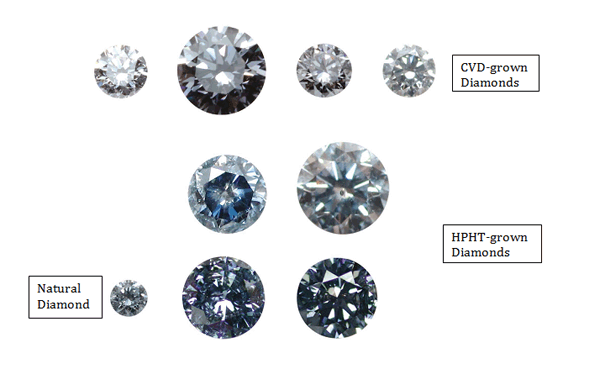|
Press Release: A distinctly new type of synthetic blue diamond from 0.25-carat to over 1.25 carats turned up in both the Bangkok and Hong Kong jewelry fairs in September 2013 along with pink, yellow and colorless varieties of other synthetic diamonds. Orion PDC Diamonds, a synthetic colored diamond producer, asserted in their promotional collateral, PDC Company, that both genuine earth-mined and lab-grown diamonds are real diamonds. While its true that both diamond types share the same physical and chemical properties, this statement nonetheless used within the context of the trade is very misleading. It would imply that lab-grown diamonds are natural, which is certainly not the case. This new generation of synthetic colored diamonds has been since identified by GRS and CGL-GRS Laboratories as being CVD-grown. A diamond expert task force was formed. After exhaustive tests utilizing both standard and advanced instrumentation, GRS – CGL-GRS has detailed conclusive results, identifying this new type of synthetic blue diamond, which had not been previously identified in scientific literature. A detailed report of their findings appears in ''GRS' Contribution to Gemmology,'' November 2013 edition. These CVD-grown blue diamonds are inert to SWUV and LWUV illumination and reveal no specific phosphorescence characteristic of HPHT-grown or natural blue diamonds. (Pictured below.) They are produced with high clarity (VVS2-VS2), and importantly, it is impossible to separate them from their similarly colored natural diamond counterparts by using a loupe or a microscope. Optical spectroscopy (UV-VIS, FTIR and PL) reveals them to be of type IIa. Their color is the result of strong absorption of very intense silicon-related center. By contrast, both natural and HPHT-grown blue diamond color is the result of boron impurity. The silicon-doped blue CVD diamonds are not electrically conductive either. Thus, an electrical conductance test is a further indicator of the CVD origin of these diamonds. This test method is also a useful identifier of irradiated blue natural diamonds, which are of type Ia or IIa, since they act as electric insulators. Natural blue diamonds are some of the costliest and rarest diamonds in the world, next to natural pinks. Almost every color of natural diamond is now being replicated in the lab. Previous limitations with growing these stones over one carat have now been surpassed. Today, an increasing number of commercial labs producing diamonds are in operation, especially in Asia due to lower production costs. CVD technology seems to be increasingly employed to grow both near-colorless and colored diamonds. This development makes it imperative for buyers to vigilantly screen all melee and small colored diamond parcels for determination of synthetic diamond, especially in the Asian markets. (Story continues after the photo.)  International labs collaborated to meet demand for new synthetic diamond and treatment detection. GRS and CGL-GRS laboratories answered the call for definitive detection of synthetic diamonds and diamond treatments by networking three strategic diamond research laboratories located in Switzerland, Hong Kong and Canada. The new task force will continue its ongoing research to uncover the latest production of newer diamond synthetics and treatments as they appear in the market. They will also offer a reliable alternative to major labs around the world. GRS lab is overseen by Dr. A. Peretti, while CGL-GRS lab is managed by B. Deljanin. The collective international gem and diamond labs began operating in Lucerne in 1996, Bangkok in 1999, Hong Kong in 2009 and Vancouver in 2009 with a total staff at all facilities numbering 40.
For more information on certification please contact:
Asia: GRS Lab (Hong Kong) LTD, Dr. A. Peretti or L. Hahn; adolf-at-peretti.ch
Europe: GRS Gemresearch Swisslab AG, Switzerland, W. Bieri or Dr. F. Herzog; wbieri-at-gemresearch.ch
North America: CGL-GRS Swiss Canadian Gemlab Inc., B. Deljanin or B. Vermeulen; branko-at-cglworld.ca About the Labs: GRS-Hong Kong and GRS-Switzerland are part of the Gemresearch Swisslab network specializing in Country of Origin reports for colored gemstones. These specialist labs have recently invested heavily in research and development in order to detect new treatments and to identify diamond synthetics appearing in today's market. In 2014, GRS-Hong Kong and GRS-Switzerland will also provide testing and identification services for colored diamonds from different origins. CGL-GRS Swiss Canadian Gemlab Inc. in Vancouver, Canada (formerly Canadian Gemmological Laboratory or also known as "CGL") is a partner laboratory with GRS Lab (Hong Kong) ltd. CGL-GRS was founded in 2013. CGL-GRS is a full service laboratory specializing in identification, grading, lasering and certification of Canadian near-colorless diamonds and natural colored diamonds from around the world, including both treated and synthetic diamonds.
Rapaport News is not responsible for, and does not endorse, the content of any third-party press release. This is not a Rapaport Press Release. It has been provided as additional information for our clients.
|